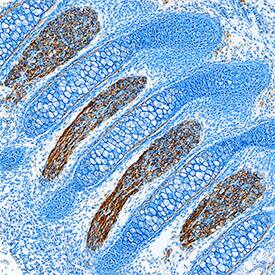Human/Mouse/Rat Contactin-1 Antibody
R&D Systems, part of Bio-Techne | Catalog # AF7549

Key Product Details
Species Reactivity
Validated:
Human, Mouse, Rat
Cited:
Mouse
Applications
Validated:
Immunohistochemistry, Western Blot
Cited:
Immunohistochemistry, Western Blot
Label
Unconjugated
Antibody Source
Polyclonal Sheep IgG
Product Specifications
Immunogen
Mouse myeloma cell line NS0-derived recombinant mouse Contactin-1
Asp21-Thr999
Accession # AAH66864
Asp21-Thr999
Accession # AAH66864
Specificity
Detects human, mouse, and rat Contactin-1 in direct ELISAs and Western blots. In direct ELISAs, less than 1% cross-reactivity with recombinant mouse (rm) Contactin-2 and rmContactin-4 is observed.
Clonality
Polyclonal
Host
Sheep
Isotype
IgG
Scientific Data Images for Human/Mouse/Rat Contactin-1 Antibody
Detection of Human, Mouse, and Rat Contactin‑1 by Western Blot.
Western blot shows lysates of human brain (hypothalamus) tissue, mouse brain (cerebellum) tissue, and rat brain tissue. PVDF membrane was probed with 0.2 µg/mL of Sheep Anti-Human/Mouse/Rat Contactin-1 Antigen Affinity-purified Polyclonal Antibody (Catalog # AF7549) followed by HRP-conjugated Anti-Sheep IgG Secondary Antibody (Catalog # HAF016). A specific band was detected for Contactin-1 at approximately 135 kDa (as indicated). This experiment was conducted under reducing conditions and using Immunoblot Buffer Group 1.Contactin‑1 in Mouse Embryo.
Contactin-1 was detected in immersion fixed frozen sections of mouse embryo (13 d.p.c.) using Sheep Anti-Human/Mouse/Rat Contactin-1 Antigen Affinity-purified Polyclonal Antibody (Catalog # AF7549) at 1.7 µg/mL overnight at 4 °C. Tissue was stained using the Anti-Sheep HRP-DAB Cell & Tissue Staining Kit (brown; Catalog # CTS019) and counterstained with hematoxylin (blue). Specific staining was localized to dorsal root ganglia. View our protocol for Chromogenic IHC Staining of Frozen Tissue Sections.Applications for Human/Mouse/Rat Contactin-1 Antibody
Application
Recommended Usage
Immunohistochemistry
1-15 µg/mL
Sample: Immersion fixed frozen sections of mouse embryo (13 d.p.c.)
Sample: Immersion fixed frozen sections of mouse embryo (13 d.p.c.)
Western Blot
0.2 µg/mL
Sample: Human brain (hypothalamus) tissue, mouse brain (cerebellum) tissue, and rat brain tissue
Sample: Human brain (hypothalamus) tissue, mouse brain (cerebellum) tissue, and rat brain tissue
Reviewed Applications
Read 1 review rated 5 using AF7549 in the following applications:
Formulation, Preparation, and Storage
Purification
Antigen Affinity-purified
Reconstitution
Sterile PBS to a final concentration of 0.2 mg/mL. For liquid material, refer to CoA for concentration.
Formulation
Lyophilized from a 0.2 μm filtered solution in PBS with Trehalose. *Small pack size (SP) is supplied either lyophilized or as a 0.2 µm filtered solution in PBS.
Shipping
Lyophilized product is shipped at ambient temperature. Liquid small pack size (-SP) is shipped with polar packs. Upon receipt, store immediately at the temperature recommended below.
Stability & Storage
Use a manual defrost freezer and avoid repeated freeze-thaw cycles.
- 12 months from date of receipt, -20 to -70 °C as supplied.
- 1 month, 2 to 8 °C under sterile conditions after reconstitution.
- 6 months, -20 to -70 °C under sterile conditions after reconstitution.
Background: Contactin-1
Alternate Names
CNTN1, Contactin1, F11, F3cam
Gene Symbol
CNTN1
UniProt
Additional Contactin-1 Products
Product Documents for Human/Mouse/Rat Contactin-1 Antibody
Product Specific Notices for Human/Mouse/Rat Contactin-1 Antibody
For research use only
